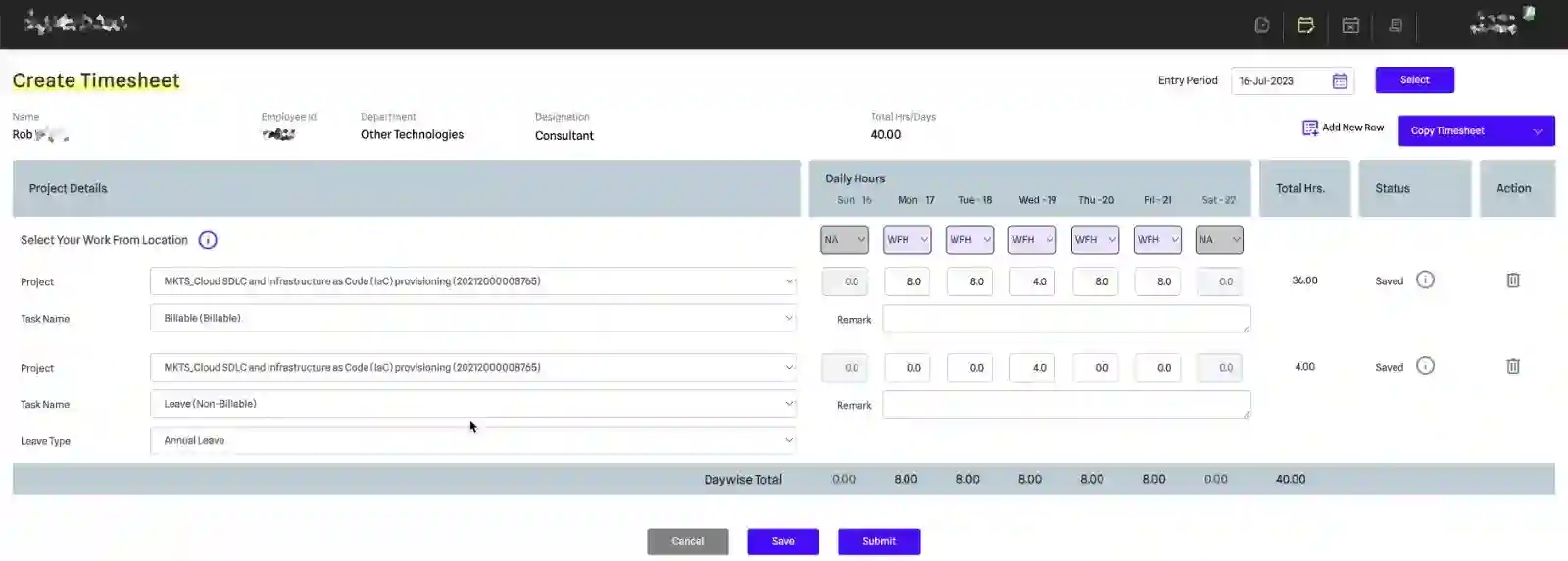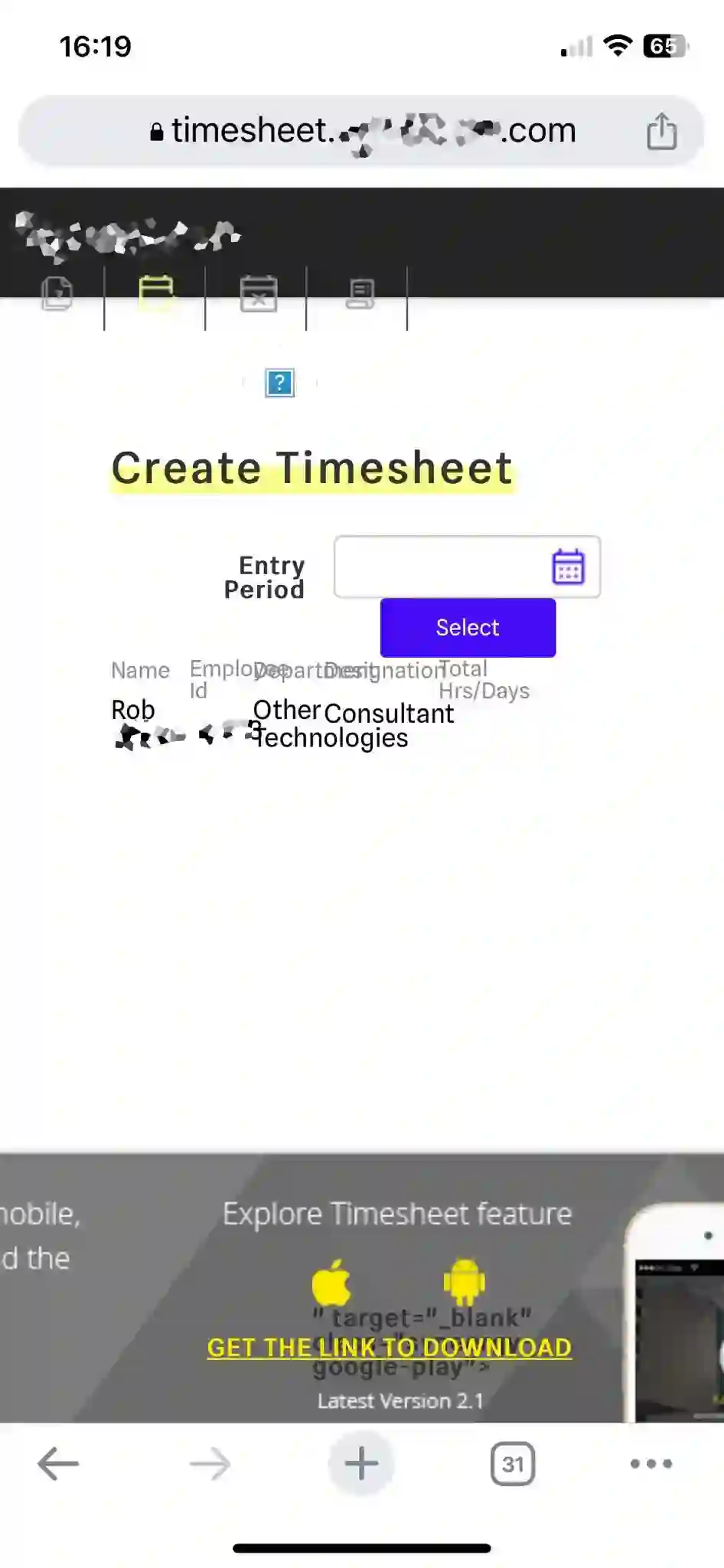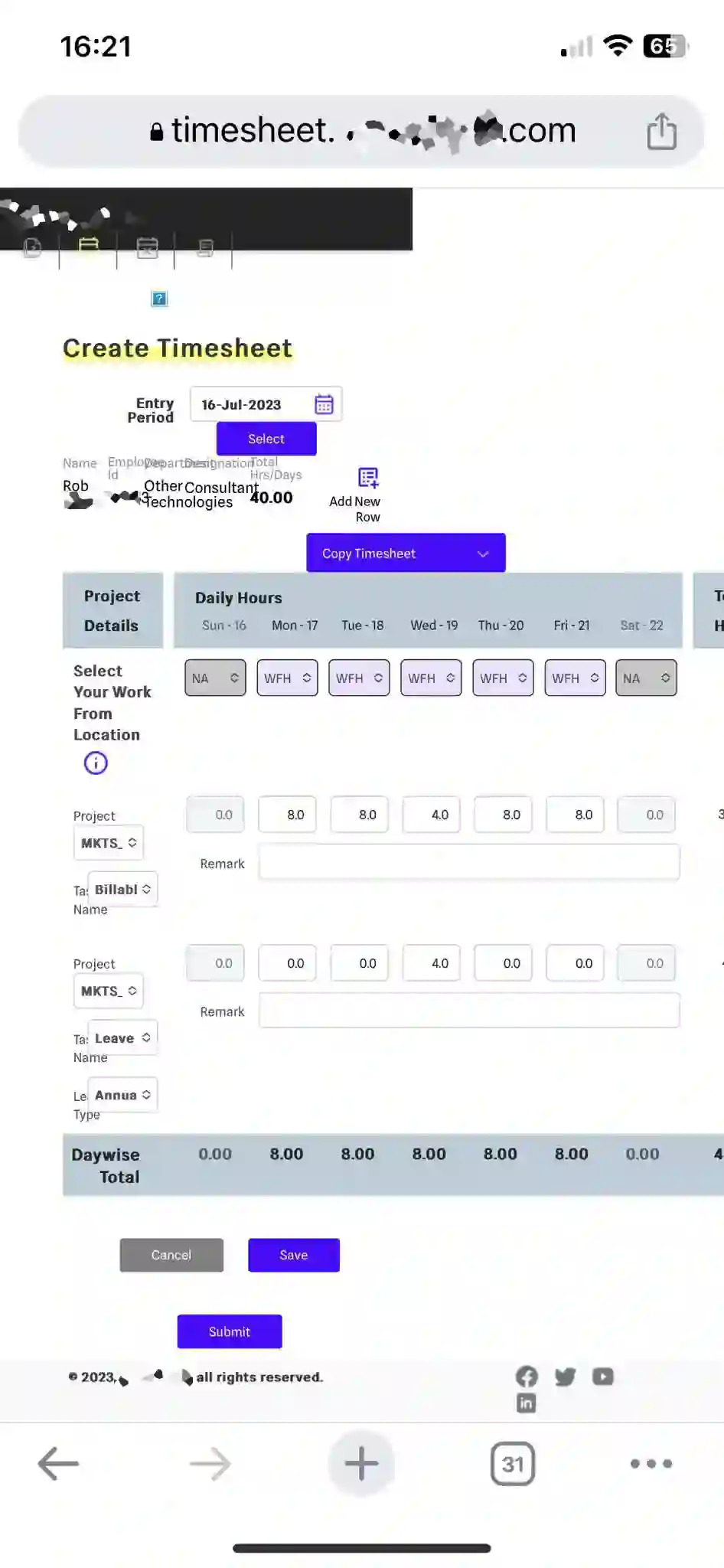Timesheet Portals: How Derelict UX Reflects Poorly on Staffing
11 Aug 2023
11 Aug 2023 by Luke Puplett - Founder

The war for talent rages on, with companies battling to attract top candidates. While most focus on office perks and amenities, the digital employee experience proves even more important. Nowhere does this ring more true than the staffing world.
Take for example the timesheet portal used by a leading global staffing firm supplying contract workers to a major US investment bank. Its users (victims?) vent about its confusing interface, and how it doesn't display on a mobile phone essentially rendering it non-functional. Contractors often don't have the energy to pay themselves and put it off until they're feeling patient and logged-in at a wide enough screen.
Take a look. This is a newly-built timesheet portal.

The feedback below is from a real user.
-
“No awareness of the current date and therefore a sensible default for the entry period - you have to select it every single time”
-
“Add new row - what the heck is it doing all the way over there?”
-
“No defaults for hours when you have a single row”
-
“No defaults for the remaining hours in a given day when you've already entered time for that day in other rows”
-
“Layout is just very clunky”
Don't worry. It gets worse.
This is the same portal on a mobile phone.


It almost hurts to look at. It appears as if the elements have been vomited onto the screen. It's not a good look for any business.
And yet it manages to get even worse.

"You can't dismiss that %*$# pop up", blurts its understandably frustrated user. The close button for the box that covers important parts of the UI is completely off the screen.
Using decimals, percentages of an hour, instead of actual minutes is standard in most timesheet portals and the cause of a lot of timesheet rejection woe and wasting of everyone's time and money.

As this real-world example shows, even prominent staffing agencies placing top talent overlook their own digital experience shortcomings. In the rest of this article we'll explore how poor interfaces and dated technology ultimately reflect poorly on the agency brand...
Internal Systems, External Impressions: Workflow Software as Brand Touchpoint
The Misplaced Emphasis on Office Aesthetics and Perks
Companies often devote endless energy to curating hip office environments - exposed brick, ping pong tables, lavish cafeterias. While physical spaces shouldn't be ignored, the outsized focus on aesthetics and perks is misplaced. Cool offices may win initial talent interest, but culture and digital experience keep them engaged long-term.
No doubt, thoughtful office design contributes to positive employee experiences. However, extravagant headquarters and excessive in-office perks are hollow without substance beneath. If the work lacks purpose and teams lack connection, no amount of workplace "cool factor" retains top talent. Furthermore, modern employees appreciate flexibility more than on-site features. An employer mandating rigid in-office presence negates any appeal from interior design investments.
Companies should ensure physical spaces support, but do not replace, meaningful work and relationships. The allure of gleaming new buildings fades quickly compared to providing fulfilling projects, autonomy, care for employee wellbeing, and software enabling productivity. Aesthetics complement but don't create an engaging employee experience alone. Balance flashy offices with deeper, holistic investments.
Seamless Software Provides Better Experience Than Office Design
The most creatively-designed open office layout pales compared to the daily frustrations of disjointed software and digital tools. Employees will overlook an average physical environment if provided best-in-class software enabling productivity and communication. They resent even the trendiest spaces when saddled with outdated legacy systems.
Seamless, intuitive software removes friction from getting work done. As more business is digital, tools optimize workflows rather than physical proximity. The best collaborative software also enables connection beyond the office walls. No layout can match that convenience. And optimized tools signal the employer values efficiency and innovation - something even the coolest office aesthetic cannot communicate.
Ultimately, employers should ensure office design never distracts from selecting and implementing software for how it empowers employees. The most productive teams seamlessly leverage great tools, not just great locations. Prioritize digital experience in parallel with physical spaces.
Optimized Digital Tools Demonstrate Focus on Tech-Savvy Talent
Employers seeking to attract top technical talent must demonstrate tech-savviness themselves. Optimized digital tools signal a commitment to innovation.
For developers, data scientists, and other specialized roles, outdated legacy systems are red flags. Clunky, disjointed software implies an employer indifferent to technology. Yet these workers thrive on elegant, well-designed platforms. An engineering-driven organization must architect employee technology with equal care as customer products.
Talented technical teams desire to build the future using modern tools - not maintain the past. Employers who empower them to do so, rather than restricting them with subpar software, win the war on talent.
Modern Platforms Signal Employee-Centric Values and Strengthen Brand
Selecting intuitive, flexible systems demonstrates an employer values user experience and enabling work, not controlling it. This strengthens branding and retention.
Employees perceive their company's values through lived experiences - like the technology they use daily. Mandating rigid, complex systems implies authoritarian values that diminish trust and morale. However, providing user-centric tools fueled by transparency and flexibility reinforces progressive, empowering values.
Likewise, modern platforms positively shape employer brand associations - efficiency, collaboration, innovation. Outdated systems reflect poorly on branding, while excellent software strengthens brand equity. Employees are proud to work where technology elevates their productivity rather than restricting it.
Subpar Software Frustrates and Repels Talent
Saddling employees with disjointed, confusing software breeds frustration and attrition. Top candidates avoid clunky systems that signal misplaced priorities. Investing in seamless, mobile-enabled platforms demonstrates a focus on the workforce. Prioritizing digital experience aids both recruiting and retention. The right software delights talent. The wrong software drives it away.
Broken tools make it painfully difficult for employees to perform critical tasks. This results in plummeting productivity and morale across teams. Talented staffers will seek alternatives rather than struggle with substandard systems long-term. Furthermore, regressive technology is a huge red flag to candidates assessing employer brand.
Conversely, providing best-in-class tools makes worklife easier. Employees are happier, more empowered, and more likely to recommend the employer to peers. For attracting and retaining top talent, investing in software that enables workers is just as important as office perks - perhaps more so.

Don't Air Your Dirty Laundry: When Internal Systems Become External
Clunky Systems Externally Reflect Internal Frustrations
Clunky, disjointed workflow systems that employees struggle with internally also provide a broken external glimpse into company operations. Frustrated employees on outdated platforms come across in customer interactions. Buggy and unoptimized software that hampers internal teams will inevitably hamper customer experience.
Don't assume poor internal systems remain unseen. Customers notice when interfaces are confusing, information is hard to find, or employees seem exasperated by technology. Projecting inward frustrations outward erodes trust and satisfaction.
Proactively Improve Workflows Before Exposing Externally
Companies should be wary of exposing messy internal systems to the public eye. Proactively address workflows that reveal frustrations or deficiencies rather than hoping customers don't notice.
Prioritize platforms that present a polished and professional external face that matches the employer brand. Don't undermine branding through poor software choices. As internal tools increasingly become client-facing, ensure they provide smooth rather than painful user experiences.
Emails and Attachments Won't Cut It
Manual Processes Signal Unprofessionalism to Clients
Leaning on emailed documents and manual processes rather than purpose-built workflow software spells unprofessionalism to discerning clients. Repetitively emailed files get lost and naming conventions break down at scale. Search becomes unreliable. Security and permissions are unclear.
Lacking workflow software means nothing connects disparate teams and projects. This breeds frustration and miscommunications internally, eventually surfacing in client interactions. Partners expecting a unified, efficient organization are disappointed.
Robust Software Demonstrates Operational Maturity
Deploying robust workflow software, not just emails and shared drives, demonstrates operational maturity to clients. Integrated systems, contextual collaboration, permissions, and audit trails project professionalism.
Invest in platforms built for scalable business needs, not just makeshift connectivity. Optimize workflows before exposing them to clients. Well-designed tools convey competence, not just aesthetics alone.
Timesheet Frustrations Reflect Badly on Staffing
Buggy Portals Signal Outdated Systems and Misplaced Priorities
Mandating buggy, confusing timesheet software ruins employee and contractor experiences, reflecting poorly on the staffing agency. Difficulty submitting hours, opaque approval flows, and lack of mobile access signal outdated systems. This results in pay delays, arguments over late approvals, and overall frustration.
When contractors have to fight with timesheet technology, it implies the agency doesn't value their time or needs. A poor interface that prioritizes accounting needs over user experience shows misplaced priorities.
Intuitive Tools Show the Agency Values Worker Time and Wellbeing
Staffing agencies should ensure their timesheet portals provide smooth user experiences. Hard-to-use tools imply the agency doesn't value worker time. Intuitive, mobile-enabled timesheets demonstrate the agency invests in the well-being of its workforce, rather than further frustrating them.
Contractors judge agencies heavily on their choice of timesheet software. Selecting modern, straightforward tools signals respect for contractors and their busy schedules. This strengthens agency brand perception and loyalty.

Conclusion
At the end of the day, employers must recognize that digital experiences are central to engaging, satisfying, and retaining talent - not just office aesthetics. While thoughtfully designed workspaces have merit, a sole focus on the physical rings hollow without modern software.
Truly employee-centric organizations invest in user-friendly tools that make work life easier, demonstrate efficiency, and reinforce brand values. They proactively identify and fix workflows that expose internal frustrations externally. They attract talent by signaling tech fluency, not just flashy headquarters.
For staffing agencies especially, outdated timesheet software directly hurts contractors and leaves a poor impression on partners. Intuitive portals designed around user needs signal true commitment to the workforce. AI-powered interfaces will further raise expectations for seamless experiences, making dated systems look even more regressive.
The next time you evaluate your employee and brand experience, examine the digital through the same lens as the physical. Prioritize platforms that empower and delight your team. The dividends overshadow any office redesign. Just don't get left behind by AI-fueled software raising user experience standards.
That's lovely and everything but what is Zipwire?
Zipwire Collect handles document collection for KYC, KYB, AML, RTW and RTR compliance. Used by recruiters, agencies, landlords, accountants, solicitors and anyone needing to gather and verify ID documents.
Zipwire Approve manages contractor timesheets and payments for recruiters, agencies and people ops. Features WhatsApp time tracking, approval workflows and reporting to cut paperwork, not corners.
Zipwire Attest provides self-service identity verification with blockchain attestations for proof of personhood, proof of age, and selective disclosure of passport details and AML results.
For contractors & temps, Zipwire Approve handles time journalling via WhatsApp, and techies can even use the command line. It pings your boss for approval, reducing friction and speeding up payday. Imagine just speaking what you worked on into your phone or car, and a few days later, money arrives. We've done the first part and now we're working on instant pay.
All three solutions aim to streamline workflows and ensure compliance, making work life easier for all parties involved. It's free for small teams, and you pay only for what you use.